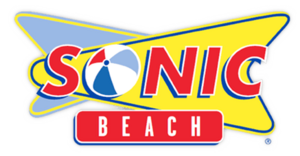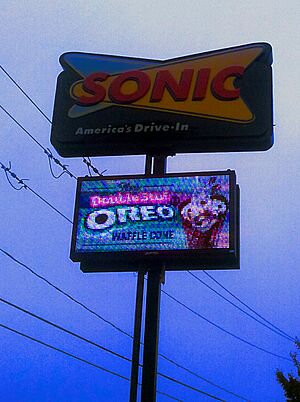Sonic Drive-In facts for kids
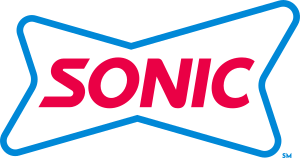
Logo since 2020
|
|
| Subsidiary | |
| Genre | Fast food |
| Founded | June 18, 1953, in Shawnee, Oklahoma, U.S. (as Top Hat Drive-In) |
| Founder | Troy Smith |
| Headquarters | Atlanta, Georgia, United States |
|
Number of locations
|
3,400+ (2024) |
|
Area served
|
United States |
|
Key people
|
|
| Products | |
| Services | Franchising |
| Parent | Inspire Brands (2018–present) |
Sonic Corporation, also known as Sonic Drive-In or just Sonic, is a popular American fast-food chain. It's famous for its drive-in style, where you order from your car and carhops deliver your food. Sonic is owned by Inspire Brands, which also owns other well-known food places like Arby's and Dunkin'.
Sonic was started by Troy N. Smith Sr. The very first location opened in 1953. It was originally called Top Hat Drive-In. What started as a small root beer stand selling drinks, hamburgers, and hot dogs has grown a lot. Today, Sonic has over 3,400 locations across the United States.
Sonic is special because it uses carhops, sometimes on roller skates, to bring food to your car. They even have a yearly competition to find the best skating carhop! Some of their most popular menu items include the "Chili Cheese Coney," "Sonic Cheeseburger Combo," "Sonic Blasts," "Master Shakes," and "Wacky Pack Kids Meals."
Contents
How Sonic Started
After World War II, Troy N. Smith Sr. returned to his hometown in Oklahoma. He first worked as a milkman, then delivered bread. Later, he bought a small diner called the Cottage Cafe. He sold that and opened a fast-food place called Troy's Pan Full of Chicken.
In 1953, Troy Smith and a business partner bought some land. On this land was a log house and a walk-up root beer stand called the Top Hat. They kept running the root beer stand and turned the log house into a steak restaurant. Smith soon noticed that the root beer stand was making a lot of money, selling root beer, hamburgers, and hot dogs. He decided to focus on the stand and bought out his partner.
New Ways to Order Food
At first, customers at Top Hat parked anywhere and walked up to order. But Troy Smith saw a drive-in in Louisiana that used speakers for ordering. He thought this was a great idea! He believed he could sell more food if customers ordered from speakers in their cars. Then, carhops could deliver the food right to their vehicles.
Smith borrowed cars to set up a parking layout. He also had people set up an intercom system in the parking lot. This new way of ordering worked wonders! Sales immediately tripled.
An entrepreneur named Charles Woodrow Pappe was very impressed by Smith's drive-in. In 1956, Smith and Pappe agreed to open the first franchise location in Woodward, Oklahoma. This was just a handshake deal! By 1958, two more drive-ins were built in Oklahoma.
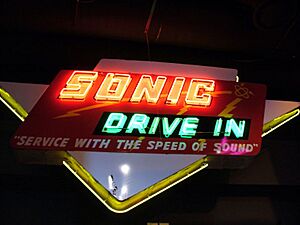
The Name Change to Sonic
Smith and Pappe found out that the name "Top Hat" was already trademarked. So, in 1959, they changed the name to Sonic. This new name fit perfectly with their slogan: "Service with the Speed of Sound." The very first Sonic sign was put up at the Stillwater Top-Hat Drive-In.
As more people wanted to open Sonic franchises, Smith and Pappe needed a way to manage it. They decided that their paper company would charge an extra penny for each Sonic-label hamburger bag sold. This money would then be split between them. This was how they started their first franchise agreements.
Growing in the 1960s and 1970s
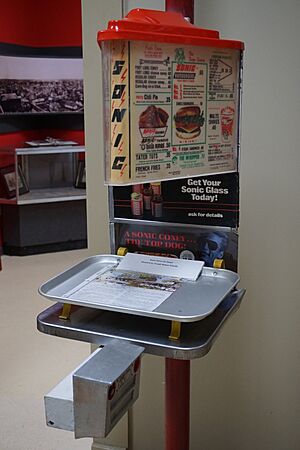
In the 1960s, Sonic's founders created Sonic Supply. This part of the company helped supply and distribute things to the franchises. By 1973, Sonic Supply became Sonic Systems of America. It helped franchisees with equipment, building plans, and how to run their stores.
During the 1960s and 1970s, Sonic grew a lot. Most of its drive-ins were in smaller towns in states like Oklahoma, Texas, and Kansas. In 1967, there were 41 Sonic drive-ins. By 1972, that number jumped to 165, and by 1978, there were 1000!
In 1968, Sonic introduced a unique item: Pickle-O's, which are fried pickle slices. In 1977, the company started the Sonic School to train managers. Many drive-ins were run by franchisees, and often the store manager became a business partner. This is still common today.
Changes in the 1980s and 1990s
In 1983, C. Stephen Lynn became the president of Sonic. He hired J. Clifford Hudson to lead the legal team in 1984. Under Lynn, Sonic and its main franchisees started local advertising groups. This helped Sonic expand into new areas and improve older markets.
A big advertising campaign with singer and actor Frankie Avalon helped Sonic become a nationally recognized name. In 1986, Lynn and some investors bought the company, making it private. The next year, Sonic moved its offices to downtown Oklahoma City.
In 1991, Sonic became a publicly traded company again. This means its stock could be bought and sold by the public. By 1994, the company had updated its agreements with franchisees.
In the mid-1990s, Sonic was opening 100 to 150 new stores each year. Starting in 1998, Sonic began a program called "Sonic 2000." This program aimed to redesign and update all 1,750 stores to have a new "retro-future" look.
The 2000s and Beyond
J. Clifford Hudson became chairman of Sonic Corp. in 2000. In 2002, Sonic introduced PartnerNet, an online system that connected all Sonic Drive-in locations. This new system helped with things like credit card processing and video training. It also brought Sonic Live Radio, a unique live radio style for the stores.
Sonic gained more attention in 2003 when the reality show The Simple Life featured Paris Hilton and Nicole Richie working at a Sonic location.
In 2003, Sonic celebrated its 50th birthday. They briefly brought back the Birthday Cake Shake and the popular Pickle-O's. Sonic also celebrated opening its 3,000th drive-in in Shawnee, Oklahoma, and its 3,500th in Algonquin, Illinois.
In 2005, Sonic started installing card readers at its drive-in stalls. In 2007, the company opened its first stores in the Northeastern United States.
In 2009, Sonic started a program called "Limeades for Learning" with DonorsChoose.org. This program helps public school teachers get supplies and materials they need. Sonic customers vote on how to give away over $500,000 each autumn. By 2016, Sonic and its franchisees had donated over $6 million, helping more than 349,000 students.
Despite expanding into new areas, Sonic faced challenges during the 2008–2009 recession. In 2015, Sonic opened its first location in Rhode Island, receiving 500 orders on its opening day! In the mid-2010s, the company began to add more stores again.
Recent Years: 2010s and 2020s
In 2010, Sonic changed its soft-serve ice cream to meet the FDA standards for real ice cream. They also added new hot dog items.
In 2017, Sonic announced plans to open seven new stores in Hawaii. In September 2017, Sonic opened its first location in Alaska, followed by a second in Fairbanks a year later.
On September 25, 2018, Atlanta-based Inspire Brands announced it would buy Sonic for $2.3 billion. The deal was completed on December 7, 2018.
In 2020, Sonic introduced a new drive-in design. This design features wider car docks, an updated drive-thru lane, and a more efficient kitchen layout.
By March 2020, all Sonic locations temporarily stopped patio dining due to COVID-19. However, they continued to serve take-away and pickup customers.
In November 2020, a serious incident occurred at a Sonic Drive-In in Bellevue, Nebraska, where people were hurt.
In 2020, Sonic added a tipping feature to its online ordering app. In 2021, they added an option to tip directly at the stalls.
About Sonic Corporation
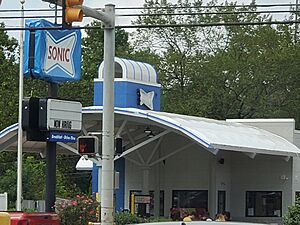
Sonic has been around since the 1950s, but Sonic Corp. officially became a company in Delaware in 1990. Its main offices are in Oklahoma City. Most Sonic restaurants are owned and run by franchisees, which are independent business owners who operate under the Sonic brand.
Working at Sonic
In February 2019, some employees at three Ohio locations left their jobs. This was due to changes in management and disagreements about pay. Sonic stated that claims of a 50% pay cut were not true.
Sonic Beach Locations
In 2011, Sonic opened special locations called Sonic Beach in Florida. These locations had outdoor seating and flatscreen televisions. Unlike regular Sonics, some of these locations did not have drive-in stalls because they were near beaches.
Sonic Beach locations offered extra menu items like popcorn shrimp and pulled pork sandwiches. They also served beer and wine. Most of these locations have since been changed back to the traditional Sonic name, but some still use the Sonic Beach logo.
Advertising Sonic
Sonic's first TV advertisement aired in 1977. A very popular advertising campaign from 1987 to 1993 featured Frankie Avalon. In 1999, a new campaign started with a character called Katie the Carhop.
Sonic has also been involved with NASCAR. They sponsored Dale Earnhardt Sr. in 2001 and then Kevin Harvick until 2003. Sonic returned to NASCAR in 2015, sponsoring Sam Hornish Jr..
Since 2004, Sonic has become more widely known across the country through its TV ads. These ads often feature pairs of improvisational actors, like T. J. Jagodowski and Peter Grosz, who became very famous for their "Two Guys" commercials. Later, other duos appeared, including Ellie Kemper and Jane Krakowski as "Two Gals." In 2020, Sonic changed its campaign to "Everyday People," featuring families instead of just two friends.
Here are some slogans Sonic has used over the years:
- "Service With the Speed of Sound" (1958)
- "America's Drive-In" (1987)
- "No Place Hops like Sonic" (1990–1993)
- "It's Sonic Good" (2003-2011)
- "This is How You Sonic" (2011–2020)
- "Mmm. Sonic." (2022)
- “Live Free, Eat Sonic” (2024)
|
See also
 In Spanish: Sonic Drive-In para niños
In Spanish: Sonic Drive-In para niños


